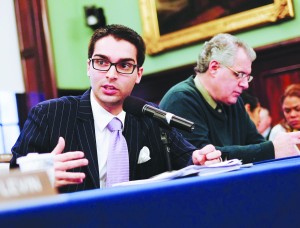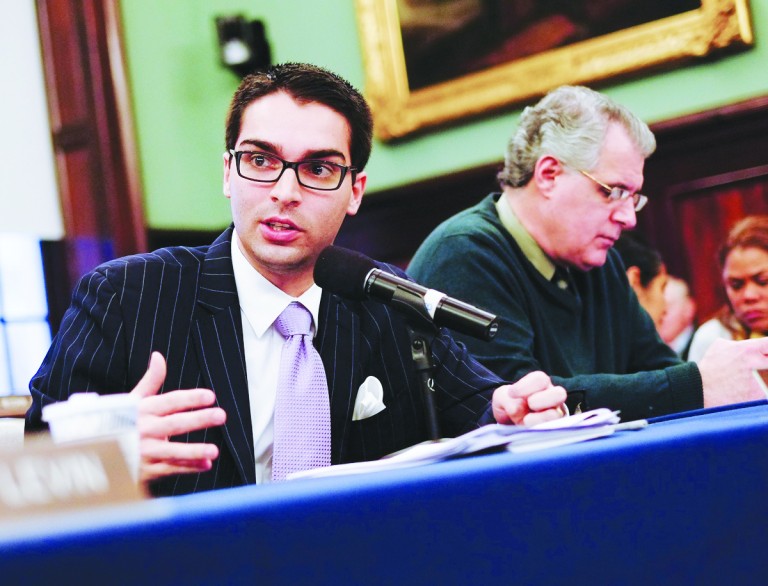
Councilman Eric Ulrich, whose district was decimated by the storm, was among a very determined coalition of council members looking for answers from Deputy Mayor Halloway and OEM Commissioner Joseph Bruno. Photo courtesy of William Alatriste, NYC Council
The City Council on Jan. 16 grilled two high-ranking members of the government about New York City’s preparedness for Superstorm Sandy.
Cas Halloway, deputy mayor for operations, and Joseph Bruno, office of emergency management (OEM) commissioner, faced a barrage of questions from the City Council’s various committees about the timing of when food, blankets and medical assistance were deployed to the thousands of residents suffering the storm’s wrath.
The hearing was the first of several that will be held about the city’s response to Sandy. In a report issued by the City Council, the city’s response was scrutinized in several key areas. The timing and scope of the storm evacuation, communication with the public, OEM coordination, addressing the needs of vulnerable populations and handling a high volume of 911 calls.
Councilwoman Elizabeth Crowley questioned Halloway about why, in her estimation, the 911 system failed during the storm. Halloway disagreed, arguing that the average wait time for a 911 operator was five and a half minutes.
“There is no data that I have that shows that jobs during the storm were misrouted,” he said.
Fire and police unions officials disagreed. They said that the Unified Call-Taking System led to the forwarding of non-emergency calls to Fire Dept. dispatchers. This, they said, lengthened response times. Bottlenecks in the system made it more arduous for dispatchers to assign critical emergencies to first responders, they said.
In a post-hearing report, the City Council concluded that they wanted to investigate further into how seniors, the physically and mentally disabled and the homebound were provided for in the days following the storm. Reports were rampant of New Yorkers stranded in dire straits after the storm struck, left without food, electricity, or running water.
“Reports contend that the City did not adequately prepare to provide the City’s special needs populations with these necessities and that the City did not make efforts to identify or conduct outreach to seniors, disabled people, and others who could not leave their homes,” the report stated. “In addition, the Committees want to know how clients of the City’s HIV/AIDS Services Administration were attended to during the days following the storm and if they were provided with adequate services.”
Council members were also concerned that residents were not granted the proper amount of time to evacuate. They questioned whether the Bloomberg Administration gave sufficient prior warning to people living in Zone A and should have revised the zoning map earlier.
“For example, when issuing the mandatory evacuation order, Mayor Bloomberg’s message could have been seen as underplaying the severity of the storm’s impact on the City when he stated that he told Governor Cuomo that New York City will be able to help upstate counties in their relief efforts,” the report stated. “The Committees are concerned that many people did not evacuate Zone A because they did not feel as though there was an imminent need to do so. There are approximately 375,000 residents in Zone A, including 45,000 living in public housing, yet the highest recorded number of evacuees at the City’s emergency shelters was only 6,800.”
The report added that this also resulted in the need for multiple search-and-rescue operations which, in the City Council’s words, diverted resources and put the lives for first responders at risk.
City Councilman Eric Ulrich, whose district encompasses hard hit areas of Howard Beach, Broad Channel and the Rockaways, said the council is looking toward what they can do to ensure future situations will be met with more planning and resource.
“The City Council is in the process of examining the city’s emergency preparedness concerning Hurricane Sandy. While several agencies, including the Department of Sanitation, Fire Department and NYPD, did a superb job, others such as OEM still have a long way to go,” said Ulrich. “We will take a closer look at the city’s planning, response and recovery efforts before, during and after the storm and make recommendations for improvement.”
By Ross Barkan

